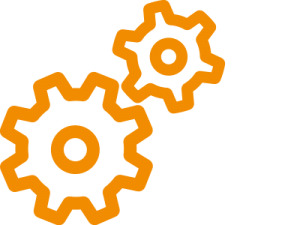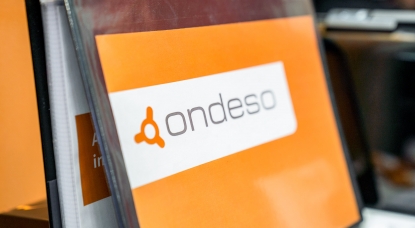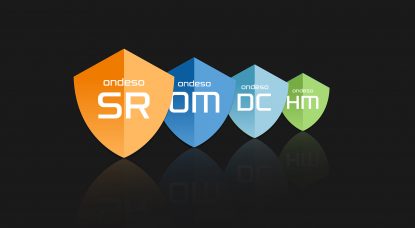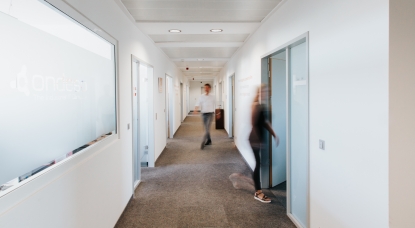“Design is not just what it looks like and feels like. Design is how it works.” [1] – Many successful entrepreneurs revolutionized the software and technology industry with innovative trends and used all facets of design. Especially in software and product design, for example, design goes beyond the purely external shape and color design of an object and is primarily focused on functionality and usability. Through a clever combination of principles such as empathy, focus and impute, the cornerstone for agile methods, especially for design thinking, was created. [2]

Agile methods are also used at ondeso to make the future of OT infrastructures simple, secure and efficient. The daily Design Doing composed of different methods and applications is under the main aspect of user-centered development. Design Thinking with its unconventional mindset is the basis for creative solutions and additionally emphasizes the necessary empathy.

Design Thinking is a concept by David Kelly, the founder of the design and innovation agency IDEO. The approach was taught, significantly influenced and further developed by professors Terry Winograd and Larry Leifer at Stanford University. [3]
Design Thinking aims to use interdisciplinary perspectives and experience to design creative and effective solutions and test them directly. Continuous optimization through the integration of feedback, allows ideas to grow and innovation to emerge.
The five-step process should not be seen as a rigid schedule, because the different phases do not have to be handled in a certain order. Rather, Design Thinking describes an iterative process in which it is possible to return to a previous phase at any time. [4] The duration of each phase depends on the knowledge and experience that has already been gained.
But not only new projects can be carried out with the help of this process, existing software solutions also benefit from a continuous improvement process involving various perspectives.

In the following, a typical run-through of the five phases Empathize, Define, Ideate, Prototype and Test [5] is shown on the basis of software development at ondeso:
Step 1: Empathize
The first phase called Empathize is about building empathy with the end user within the design challenge. The aim is to fully understand use cases and current processes and thus to understand the challenges involved. By collecting different manipulations and ways of thinking, the information content converges and increases understanding.
Step 2: Define
In the next phase Define wishes and needs are worked out and combined with empirical values and existing functionalities into a common context. The aim is to focus on a specific point of view, so that a clear definition of objectives is created on the basis of the developed understanding.
Step 3: Ideate
Ideate creates the transition to the design of a concrete solution. In this phase, a variety of realisable solution options are developed. The resulting ideas are structured and prioritised and always checked against the objectives. The challenge here is to allow creativity and to develop unconventional ideas. In this way, out-of-the-box solutions are created which would not have been possible under classical processes. An innovative idea is characterized by the fact that the three components attractiveness, feasibility and economic efficiency are optimally combined.
Step 4: Protoype
These results are the input for the implementation in the Prototype phase. Here the already existing product is brought together with the innovative approaches and visualized with different level of detail. A prototype can take various forms and can initially only be drawn on paper.
Step 5: Test
The prototypes are checked in the Test phase and continuously refined based on feedback. Focused test runs help to quickly identify and adjust errors and to consider alternative implementation options.

However, the mindset is the key factor in this implementation. At ondeso this is composed of several principles that are important for the creative progress:
The approach of continuous improvement serves as a superior way of thinking by striving for constant optimization. This philosophy is derived from the Japanese concept Kaizen. Thereby it is important to overcome boundaries, to question daily actions regularly and to strive for optimization. [6]
In addition, the composition of a homogeneous and yet interdisciplinary team is essential, because different perspectives increase inspiration and thus creativity. A good mix raises the competence to find solutions.
Of course, the integration of the customer is the main factor here. By holding regular key user meetings, ondeso stays in active exchange with existing customers. In combination with the company’s ten years of experience in the industry, ondeso works together with the user in the center of development on new possibilities to increase IT security in OT infrastructures.
Sounds interesting? Here you can download the summary as PDF for free:
We have briefly summarized all contents in this video for you:
[1] https://ia.net/topics/design-is-how-it-works
[2] https://www.fastcompany.com/1665375/the-6-pillars-of-steve-jobss-design-philosophy
[3] https://hpi-academy.de/design-thinking/was-ist-design-thinking.html
[4] https://designthinking.ideo.com/
[5] https://dschool.stanford.edu/resources/the-bootcamp-bootleg
[6] https://www.business-wissen.de/hb/kaizen-als-prinzip-und-was-es-bedeutet/

Would you like to learn more? Do not hesitate to contact us, we will be happy to help you.


Here you can learn more about our company and our expertise as a pioneer and market leader.